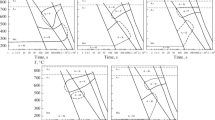Conclusions
-
1.
The conditions were determined for successive saturation of steel KhVG with carbon and boron from powdered materials. Complex diffusion layers consisting of (Fe, M)B needles and a carburized transition layer are formed that reduce the microhardness gradient from the diffusion layer to the base metal as compared with borided steel KhVG after quenching and low-temperature tempering.
-
2.
Operating tests of dies in tableting machines showed that the cyclic strength of carboborided dies is 200–250% that of borided dies. The treatment is recommended for parts of stamping and pressing machines.
Similar content being viewed by others
Literature cited
V. P. Glukov, Boride Coatings on Iron and Steel [in Russian], Naukova Dumka, Kiev (1970), p. 326.
G. S. Glushkov, Engineering Methods of Calculating Strength and Rigidity [in Russian], Mashinostroenie, Moscow (1972), p. 412.
Additional information
Translated from Metallovedenie i Termicheskaya Obrabotka Metallov, No. 12, pp. 61–62, December, 1975.
Rights and permissions
About this article
Cite this article
Alimov, Y.A., Gordienko, S.I. Successive saturation of steel KhVG with carbon and boron in powdered mixtures. Met Sci Heat Treat 17, 1062–1064 (1975). https://doi.org/10.1007/BF00664216
Issue Date:
DOI: https://doi.org/10.1007/BF00664216




